Creating In-App Message
In-App messages are messages that are displayed to the user while they are using a mobile app. You can define the content of the message and the rules for its display to target the message to a specific audience.
ImportantTo send In-App messages from our platform, you need to Install SDK.
To create a new message:
-
Go to the Messages → Messages → In-App section. Click the New In-App button.
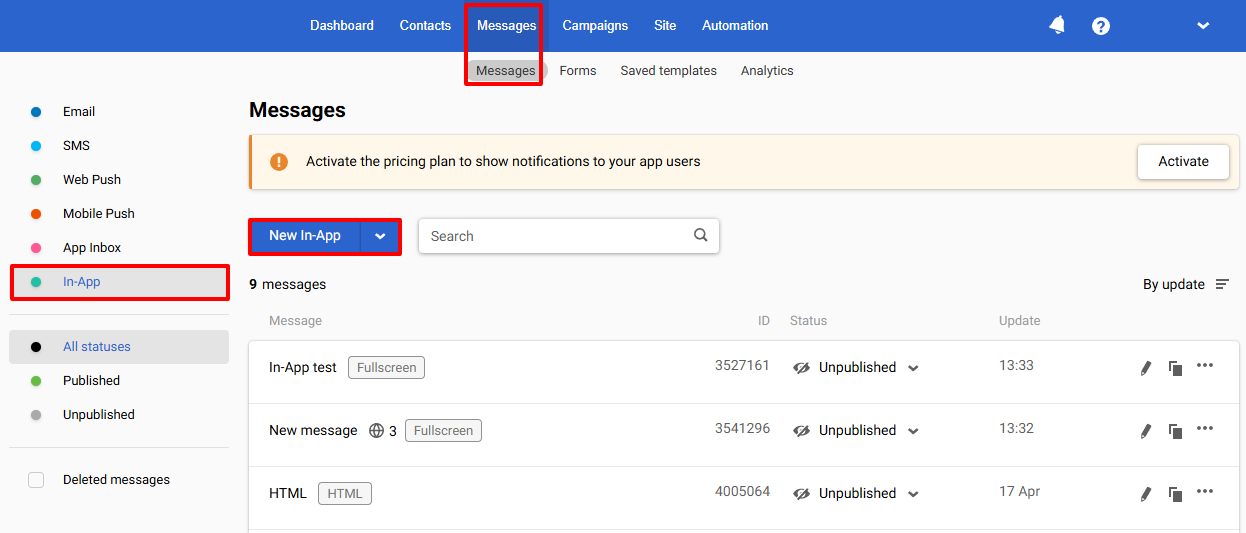
-
Select the message type:
- Fullscreen
- blocks app content
- closes by pressing the cross icon
- Popup
- blocks app content
- closes when tapping outside the message or by pressing the cross icon
- Slideup
- has top or bottom positioning
- does not block app content
- closes by swiping left/right and up/down depending on the positioning or by clicking on the cross icon
- Floating Bar
- has bottom positioning
- does not block app content
- closes with a swipe left/right/down or by pressing the cross icon
All of the above message types are created in a drag-and-drop editor. You can also use the HTML editor to get more options for customizing the message content.

NoteAll In-App message types are supported in SDK versions starting from Android 2.5.0/iOS 2.5.0.
Working in the Drag-and-drop Editor
Let's look at creating a full-screen message - the functionality of other In-App types is identical.
The components for building the message are located in the left-hand side panel. To add a component, drag and drop it to the editor field.
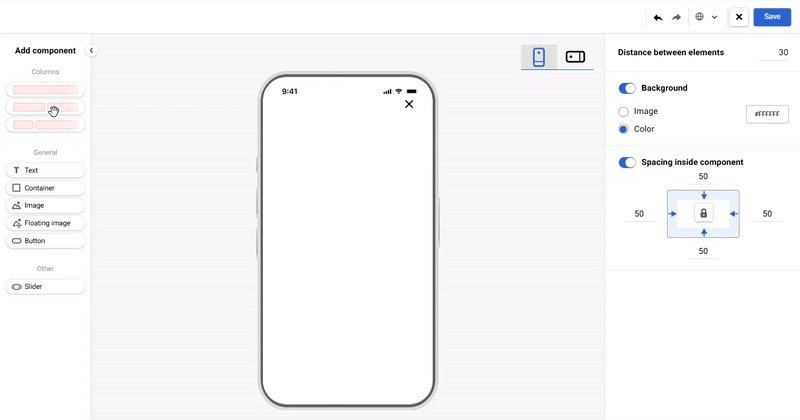
Columns and Container can contain other components, except for the Floating image component.
Floating image overlays other components. It can be used, for example, to emphasize a specific element.

The right-hand side panel of the editor contains a menu with editing options for each component. Click the relevant component to display its menu.
To return to the main layer menu of the editor, click anywhere outside the components.
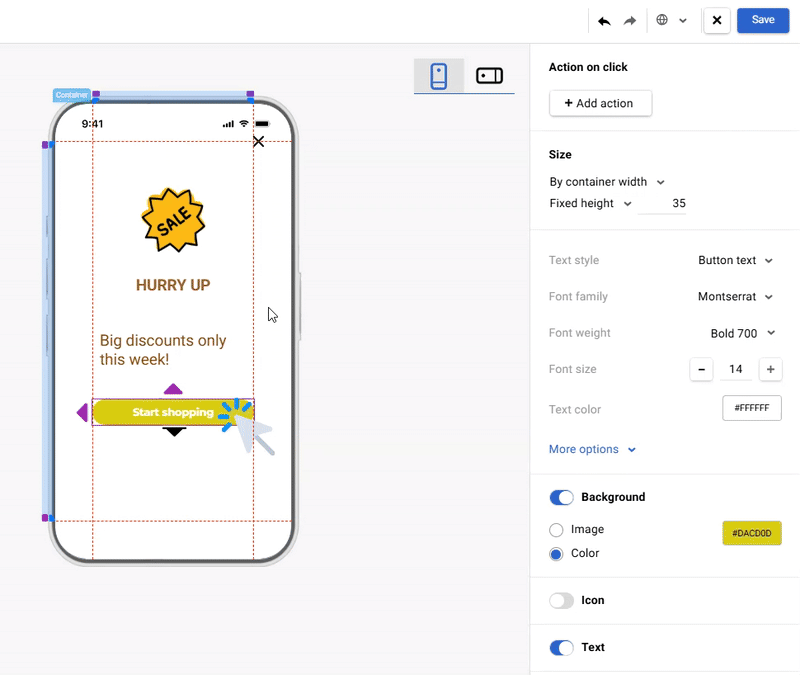
The following settings are available for the components.
Action on click
Expand the +Add Action menu and choose the action to be performed when clicking on the element:
- Open URL
- Use click tracking
- Close the current message
You can add one or several actions.
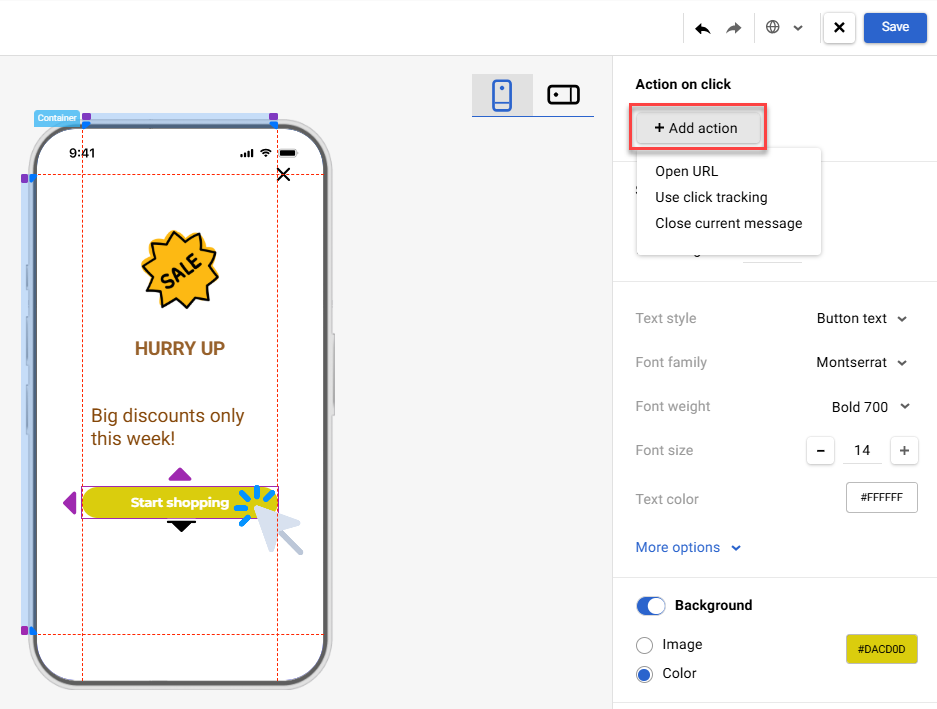
Align Inner Elements
Select the appropriate icon for aligning elements within the container or columns.
Enter the value for the distance between elements in the corresponding field. The minimum value is 0.
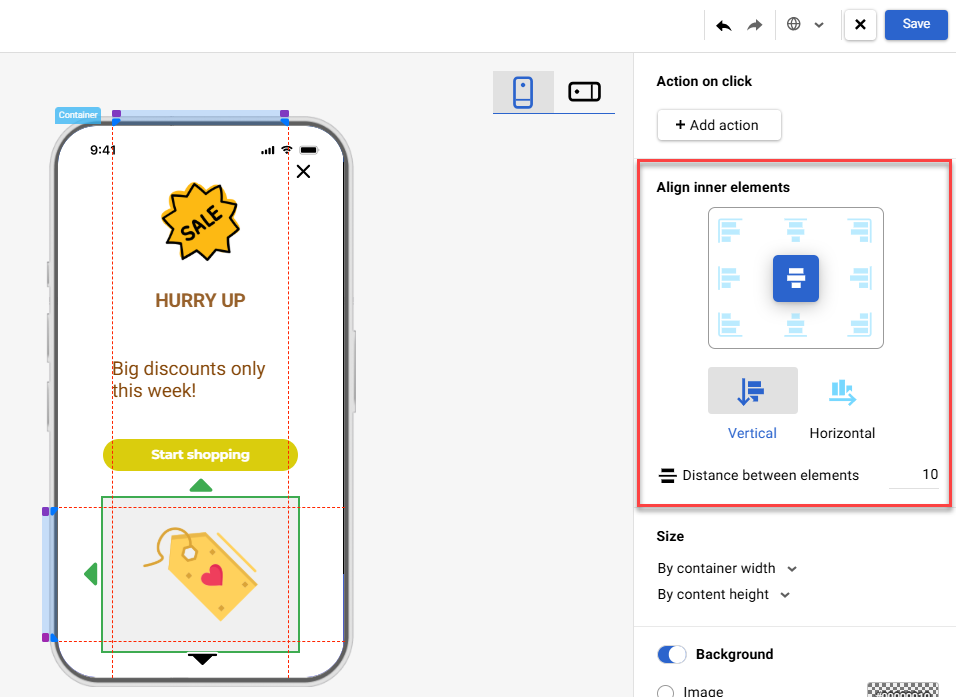
Size
Expand the drop-down lists and select the necessary sizes from the following options.
For width:
- Fixed width. The minimum value is 20.
- By container width.
- By content width.
For height:
- Fixed height. The minimum value is 20.
- By container height.
- By content height.
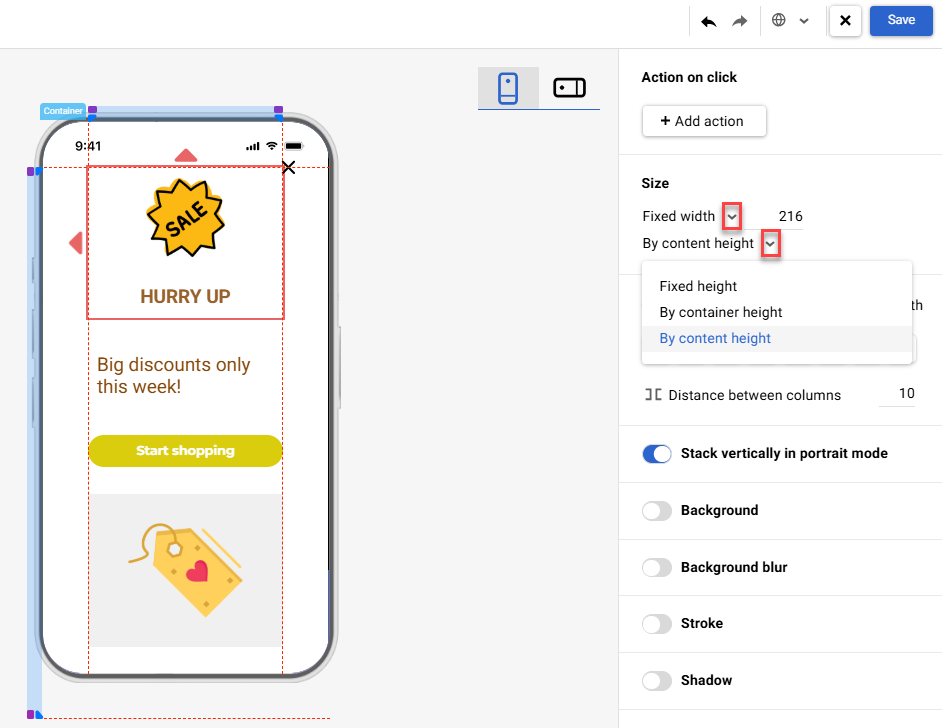
Columns
For the Columns component, you can choose the following settings:
- Equalize width. This option sets equal width for all columns.
- Number of columns. Select the number of columns from 1 to 8.
- Spacing between columns. Enter a number in the field to set the distance between columns in pixels. The range is from 0 to 40.
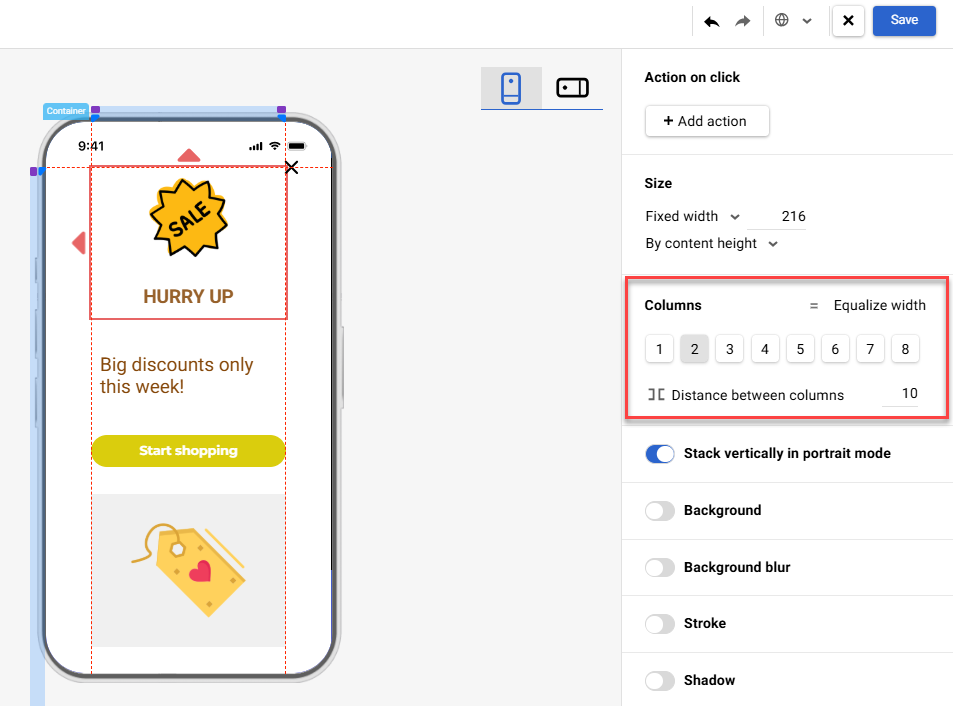
Stack Vertically in Portrait Mode
When this option is enabled, the columns are displayed vertically when the message is viewed in portrait mode.
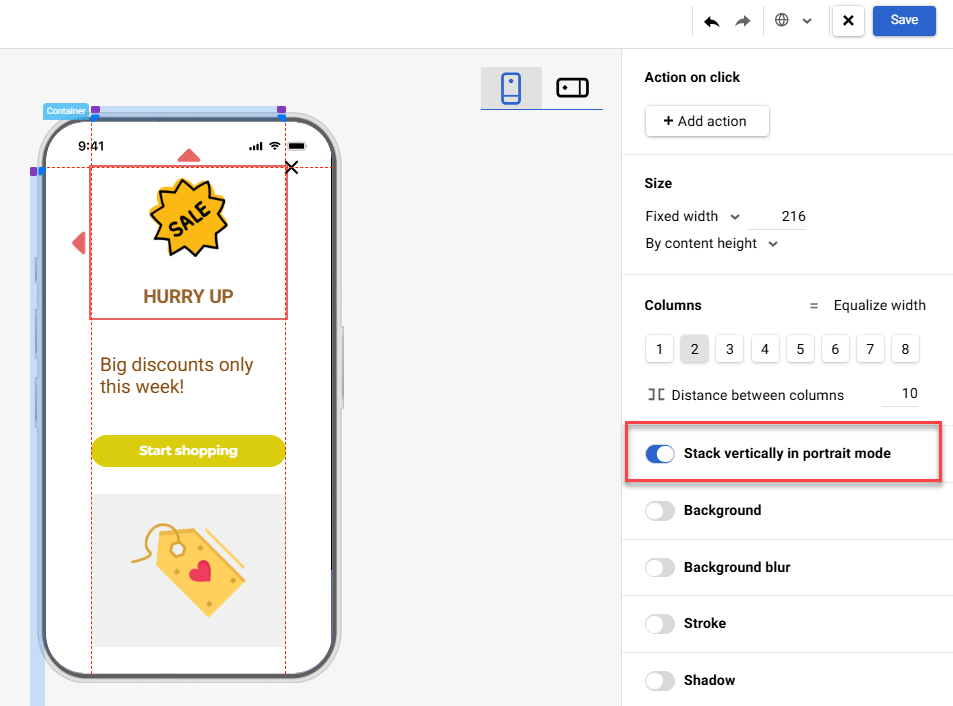
Background
To select the background of the component, activate the Background slide button and choose one of the following options:
- Image to upload your pictures or select from the built-in library.
- Color to choose the desired color from the palette or enter its code manually.
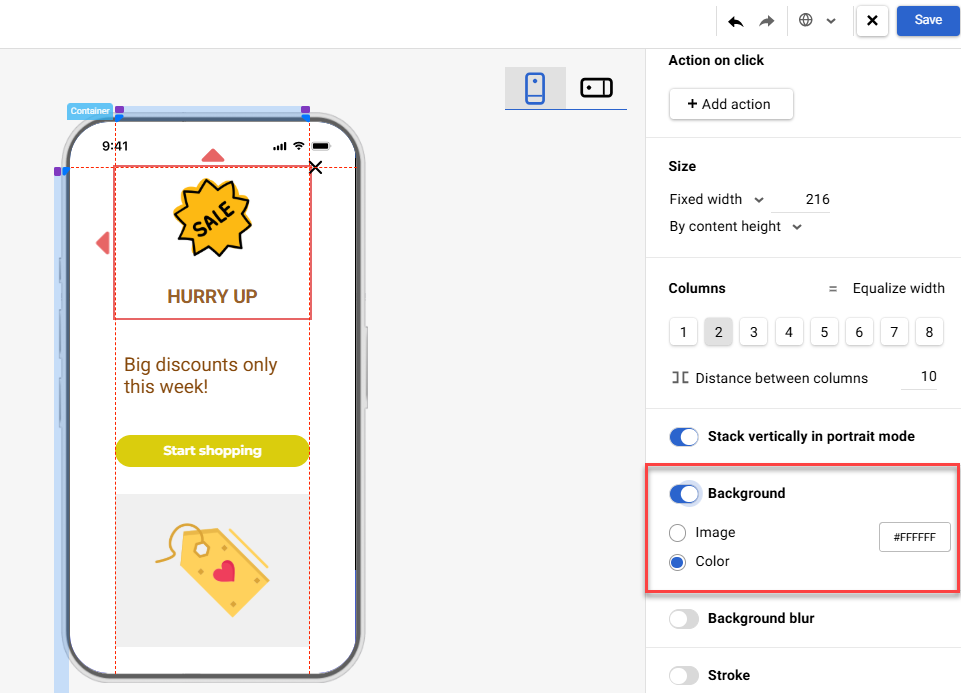
Background Blur
The acceptable values for background blur range from 0 to 100.
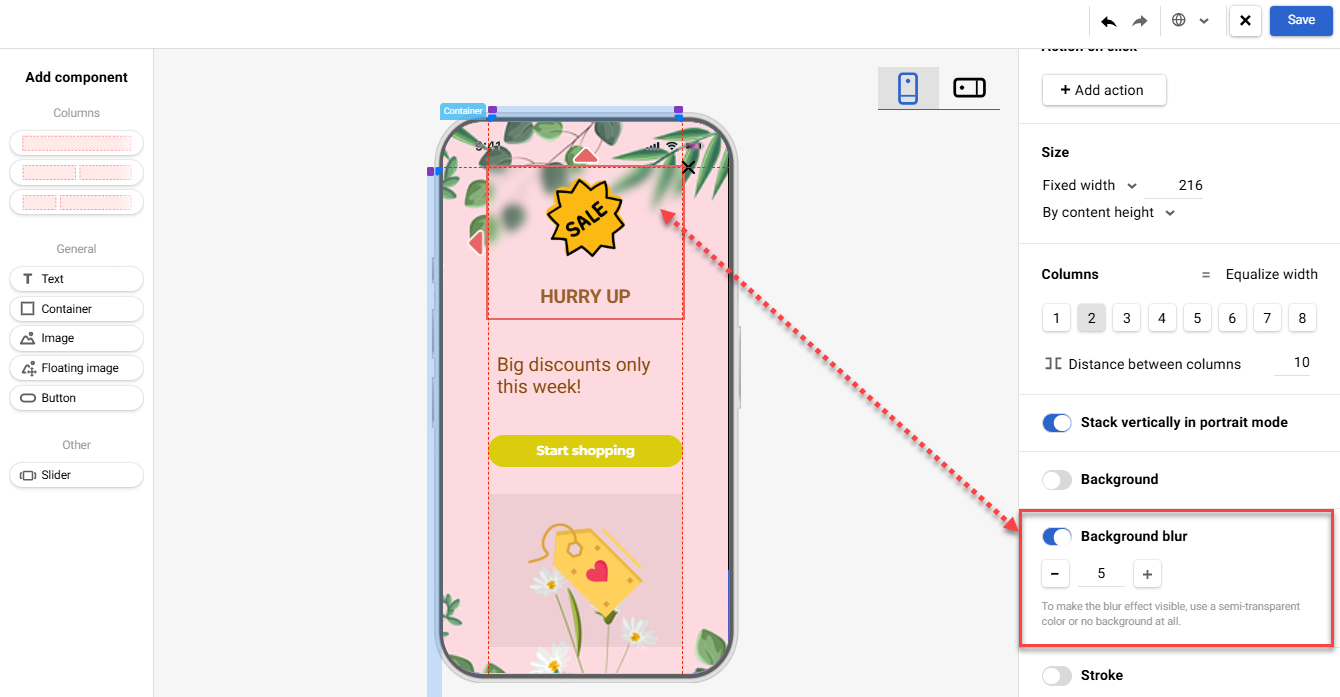
Stroke
Activate Stroke to set formatting for the outer contour of the Container and Columns components. You can set the same stroke format for all sides at once or for each individually by choosing:
- Stroke Type: solid, dashed, dotted.
- Thickness: Acceptable values are from 0 to 100.
- Color: Choose it from the palette or specify manually.

Shadow
Activate the slide button to set shadows for the component. The following settings are available:
- Vertical (x) and horizontal (y) spread.
- Blur.
- Size.
- Color.
Hover over each value field to see its minimum and maximum value.
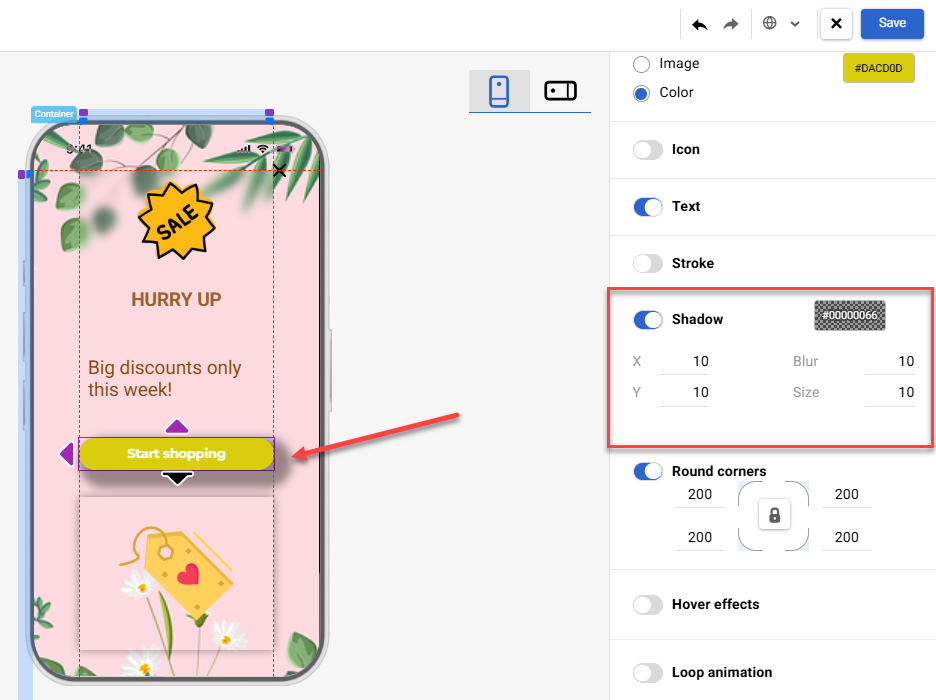
Round Corners
This option allows you to set the value for rounding the component's corners.
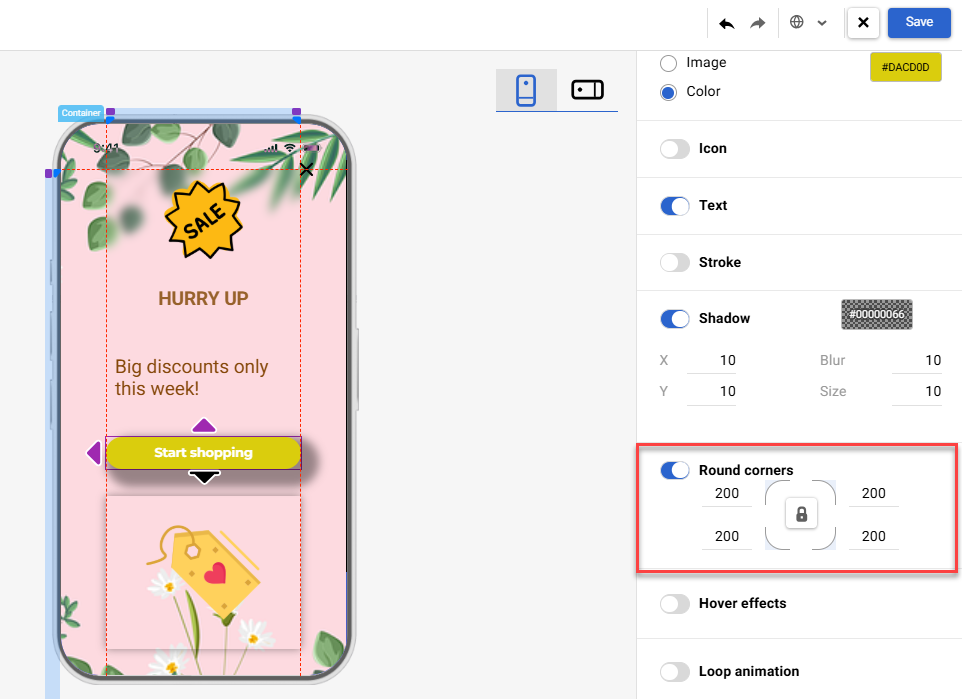
Text Formatting
Select the component that contains text to access the formatting menu.
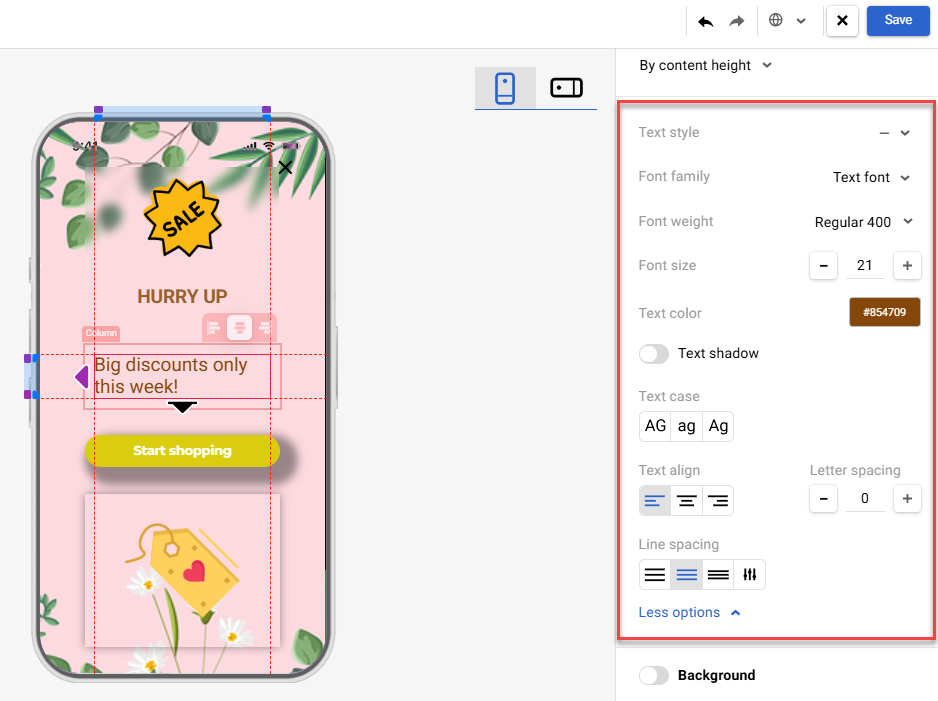
Icon
For the Button component, you can add an icon with the following parameters:
- Size
- Alignment
- Distance before text
Hover Effects
Activate the slide button to make the button more interactive when hovered over or tapped.
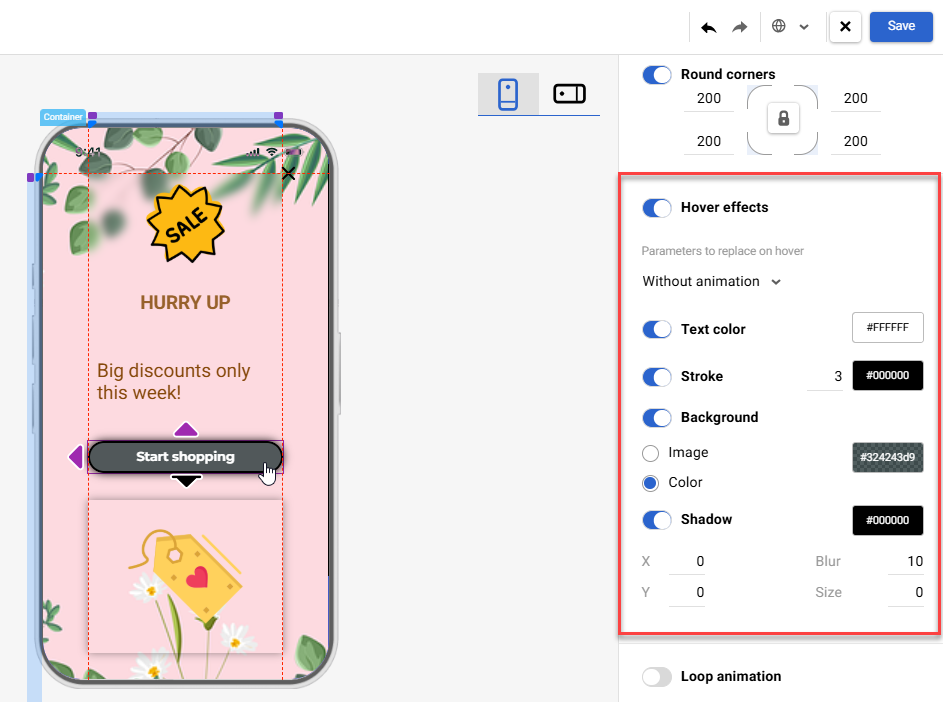
Loop Animation
The Loop animation option allows you to choose the following parameters for the Button component from the drop-down lists:
- Animation type.
- Number of repetitions.
Slider
Drag the slider from the left-side panel and drop it into the message template. Set up slider and Manage slides buttons will appear on the right-side panel.
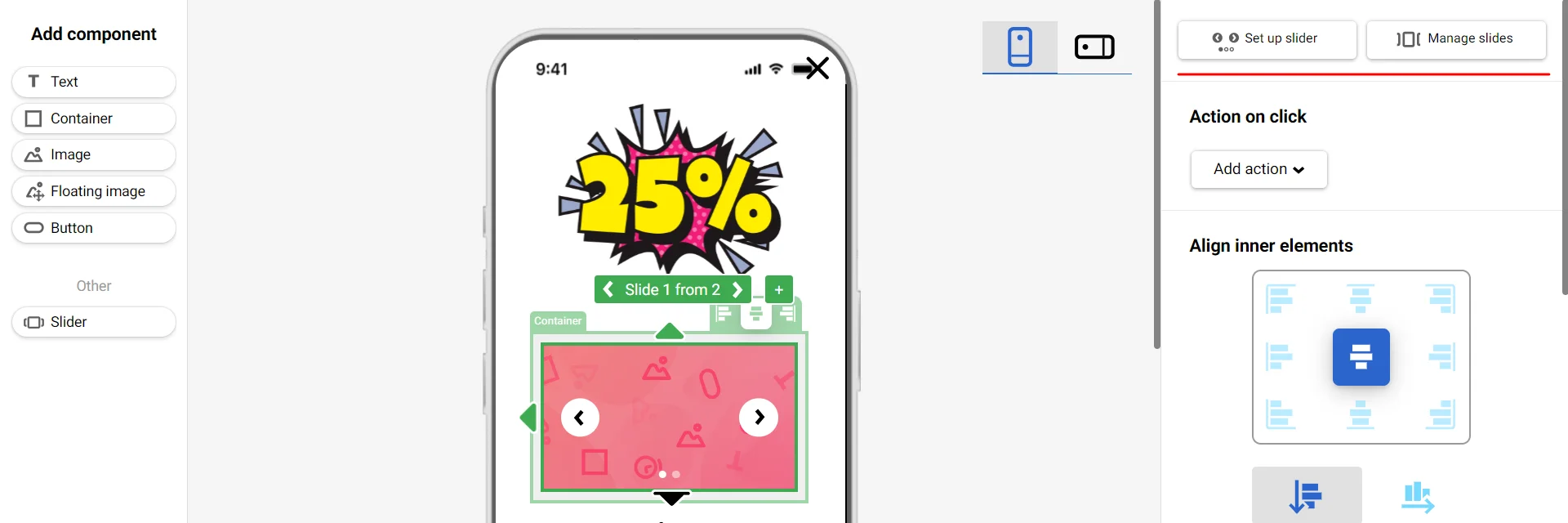
In the slider setup window, you can set up navigation buttons, indications, slideshow animation, and the slider's general design.
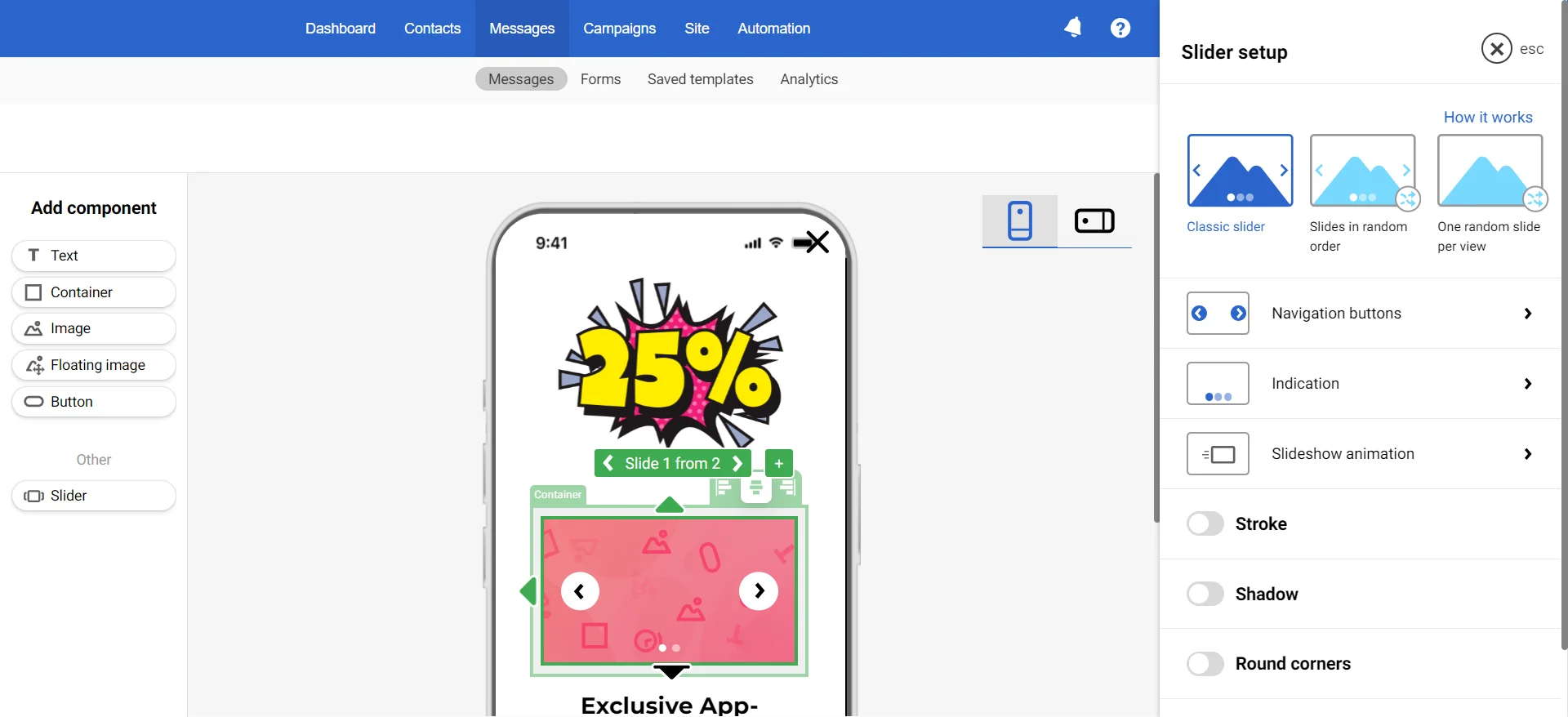
Manage slides’ order, add, duplicate, or rename slides after clicking the Manage slides button.
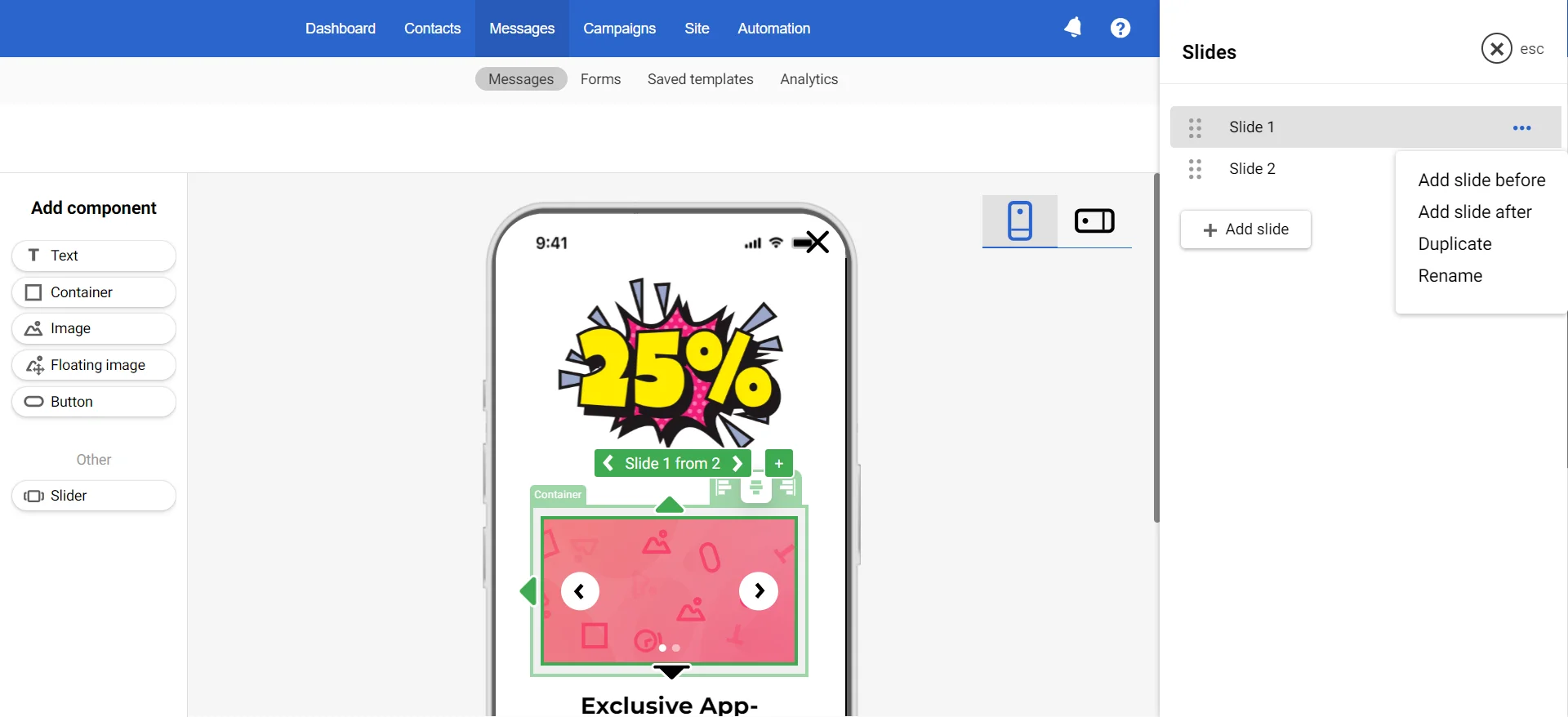
Also, you can add a slide by clicking on the + sign.

To change or edit an image, click on it in the template, after which it will appear in the right settings panel. Clicking on the image from the slider in the settings panel opens the editing window.

Use navigation buttons to switch between the slider’s images.

Set the action on click:

Context Menu
A Context menu becomes available upon right-clicking on the message component with the following actions:

- Copy
- Duplicate
- Cut
- Delete
- Put behind all floating images
- Put in front all floating images
- To container
Close Icon
The Close icon allows the user to close the message.
You can use standard and custom icons with settings for color, size, and positioning on the screen.
NoteThe position of the Close icon is calculated from the top-right or top-left corner of the message.
Message Orientation
The message can be displayed in Portrait or Landscape mode, depending on how the user holds the device (vertically or horizontally).
To see how the message will display on the device, click the Orientation icon at the editor's top.
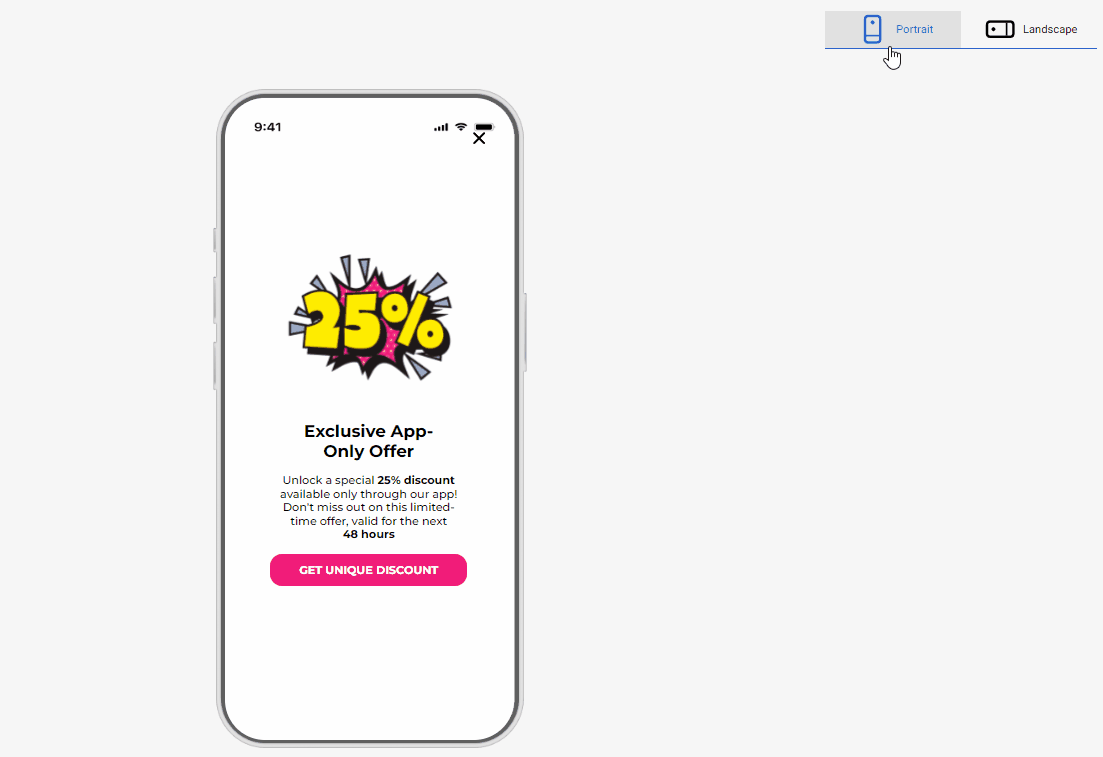
Press the Save button on the top panel of the editor to apply the changes after configuring the In-App message.

Fill in the New Message field. This field is available for searching messages in the general list; users will not see it.
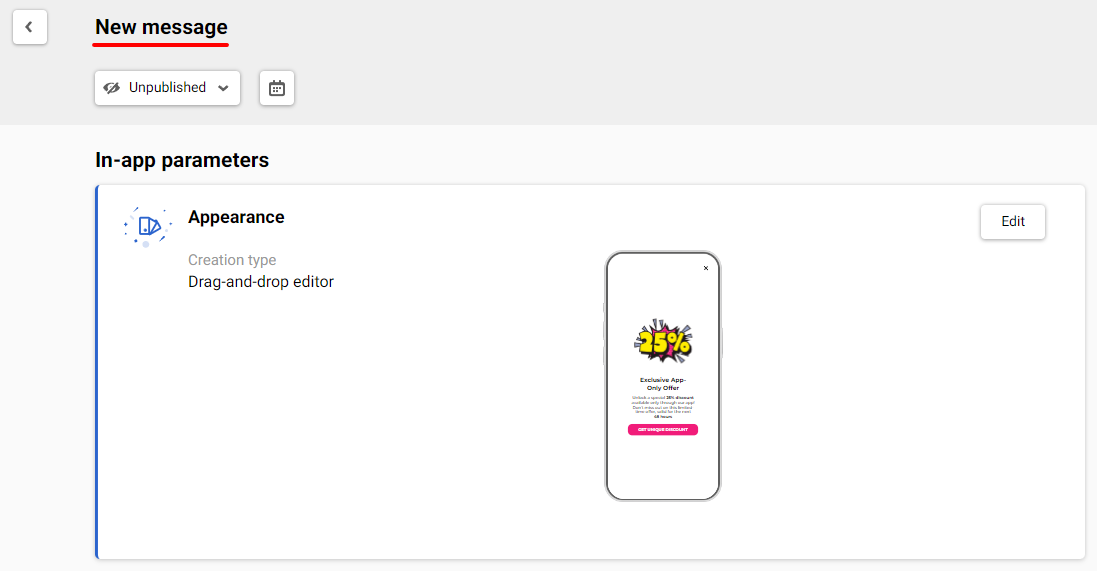
HTML Editor
This method of creating In-App messages is more labor-intensive and requires specific technical skills in working with HTML and CSS; however, it provides a more flexible approach to customizing message content.
Fill in the In-app name field.

HTML Settings
Open the HTML tab.

You can put your HTML code or use our base code.
Using base code
Copy and paste the base HTML into the code window. Insert your code instead of Your code goes here text.
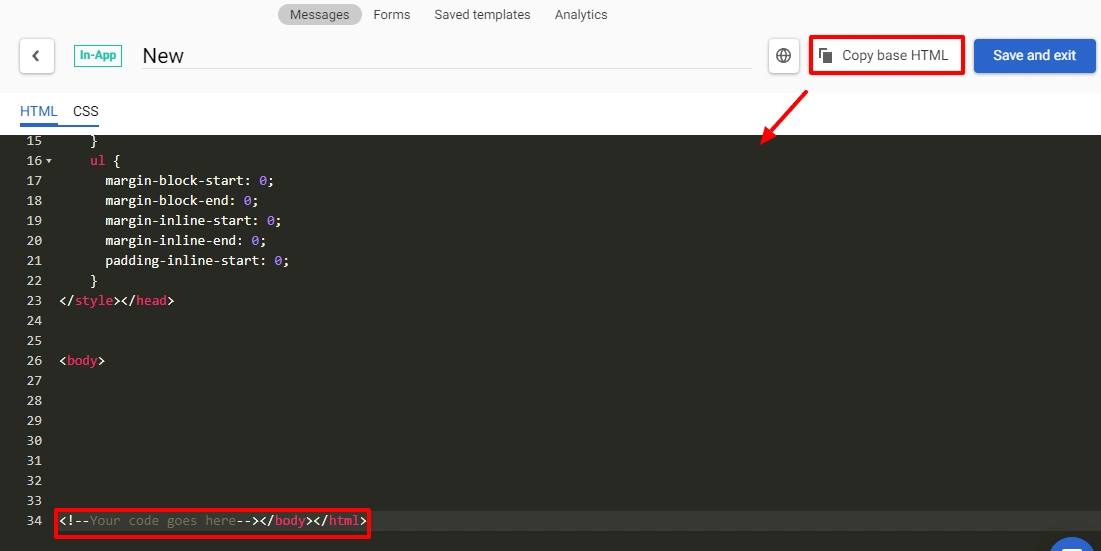
ImportantYou can use personalization by merge tags and Velocity features in the HTML code of In-App messages.
Custom HTML markup rules
- Use buttons instead of anchors
AttentionUsage of Anchor HTML elements is forbidden.
- Set data attributes for the clickable element
Each clickable element must have the required data attributes.
- Code of the button that should open the URL:
- \<button
data-target-component-id="1c92f19e-c994-11ed-afa1-0242ac120002"
data-sys-action-type="OPEN_URL"
data-sys-action-params="{"url":"<https://google.com"}">
class="button">
</button>- Code of the button that should close a widget:
- <button
data-target-component-id="c740db99-cfbb-4857-b790-cb5631c33255"
data-sys-action-type="CLOSE_WIDGET"
class="close-button">
</button>Attribute name | Attribute value |
|---|---|
data-sys-action-type | One of action:
|
data-target-component-id | Generate a unique element’s UUID (e.g., using Online UUID Generator ) |
Use Margin Top 50 px (approx) so the content does not overflow the iOS devices panel.
CSS Settings
Open the CSS tab and add CSS rules in the code window.

Adding CSS code is optional, but custom HTML is usually displayed incorrectly without CSS.
After adding the code, press the Save and exit button on the top panel of the editor to apply the changes.

Messages created using the HTML editor are marked with the corresponding icon.
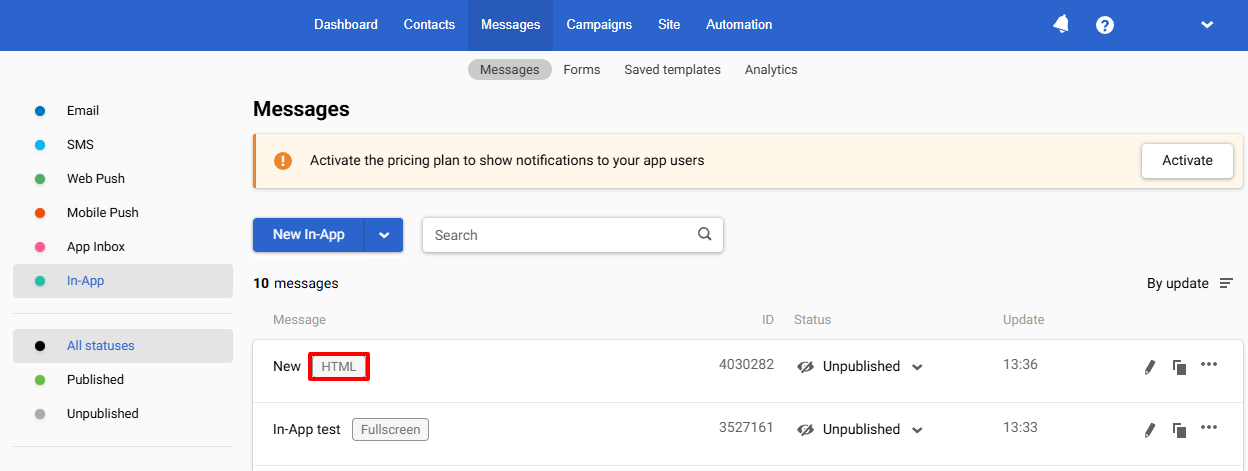
Multilingual Version (optional)
You can create multiple language message if this option is available in your pricing plan. Click the globe icon in the editor's top panel, specify the default language, and add language versions.

When adding a language version, the automatic translation option is enabled by default. To translate manually, disable it.
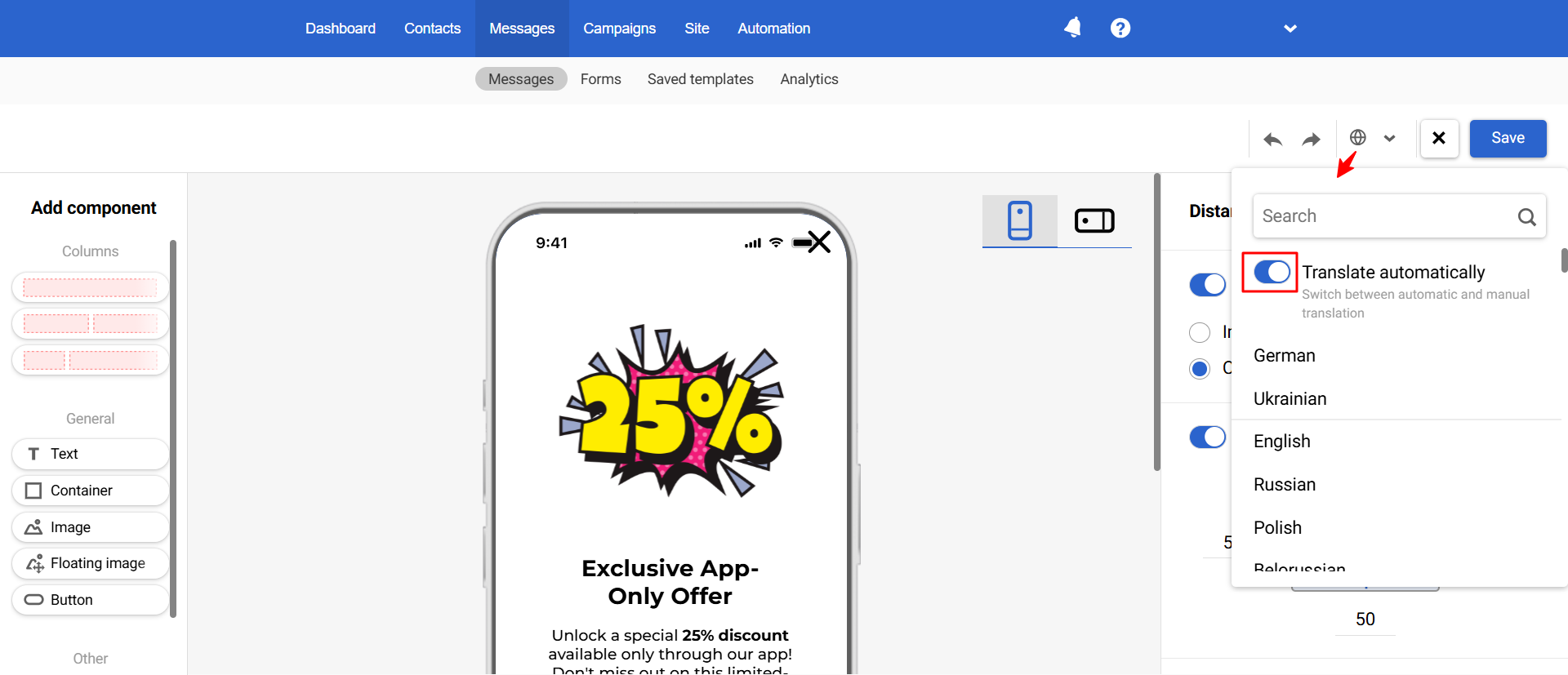
NoteThe language is determined by the device language, and not by the one written in the contact card.
Updated 3 months ago
